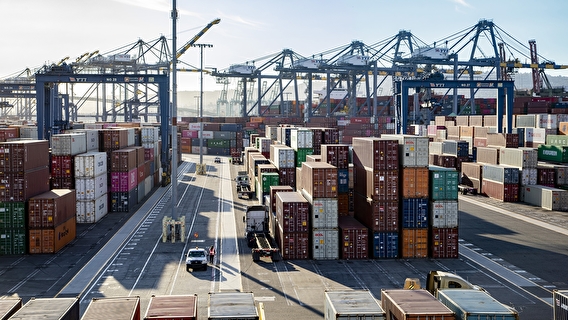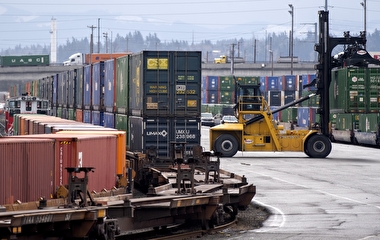
Supply chains aren’t normally at the top of the news, but pandemic-related disruptions and empty shelves have put them there. What does the future hold for freight and supply chain resilience? Speakers at the 25th Annual Freight and Logistics Symposium reviewed recent challenges and discussed how to make supply chains more cooperative, connected, and resilient.
The symposium, held December 2, 2022, was sponsored by CTS in cooperation with MnDOT, the Minnesota Freight Advisory Committee, the Council of Supply Chain Management Professionals, and the Metropolitan Council.
Issues in the supply chain
The 2022 supply chain was “a mess,” said Dan Murray, senior vice president for the American Transportation Research Institute. He cited high inflation, China’s COVID lockdown, and labor shortages as immediate contributing factors, but pointed out that these are just the latest in a long line of supply chain issues that have been compounding over the years.
“While ’22 was the perfect storm of these issues coming together and creating havoc,” Murray said, “a lot of the underpinnings have been with us for a long, long time.”
Mark Berndt, lead consultant of Quetica LLC, said environmental disruptions such as hurricanes, droughts, and disease outbreaks can have far-reaching effects across the entire manufacturing and freight industry. According to the National Oceanic and Atmospheric Administration, these billion-dollar disaster events have been on the rise since the 1980s. Moreover, just-in-time and offshore manufacturing practices, which hyper-streamline the shipping industry, leave little to no room for disruptions.

The labor shortage is a growing problem, warned Yone Dewberry, chief supply chain officer at Land O’Lakes. Dewberry said worker replacement rates have been falling as birth rates in the US decline and shippers have been struggling to fill positions. In addition, many supply chain workers have been retiring or changing careers.
“What we’ve seen is that the participation rate has gone down,” Dewberry said, “and I don’t think it’s coming back any time soon.”
Keith Prather, managing director and co-founder at Armada Corporate Intelligence, emphasized the interdependent nature of these various factors and the far-reaching “ripple effects” a single disruption can have on the entire US economy. A slowdown in chip manufacturing, for example, can lead to a backlog in the auto manufacturing industry. “Watch the trend,” Prather said, “not the number.”
Building supply chain resilience: FLOW
Speakers then turned to ideas for building resilience. Andrew Petrisin, supply chain advisor with the US Department of Transportation, presented his work with FLOW (Freight and Logistics Optimization Work)—an experimental USDOT program aimed at building shipping resilience through information-sharing and coordination.
FLOW serves as a centralized repository of shipping data, Petrisin said. Companies that participate upload company data, such as purchasing orders, bookings, terminal usage, and warehouse activity, which is then de-aggregated and de-identified. Anyone who participates in FLOW has access to this information.
“The benefits of this, we see, are extremely valuable and increase the likelihood of matching demand against logistic supply efficiently,” Petrisin said.
Jason Craig, director of government affairs at C.H. Robinson, pointed to a wealth of unique data spread across the shipping industry that, if brought together, could coordinate a very efficient system.
Dewberry, however, raised the problem of self-interest: The different players in the shipping industry are in competition with one another, and they need a trusted, third-party broker if they’re going to work together.
This, Petrisin said, is what FLOW was designed to be. “We share so many common goals,” he said. “The way I see to address this problem is by focusing less on individual institutions…and more on how those institutions interact with each other.”
FLOW is currently onboarding new participants, collecting more data, and ironing out issues. Craig said the program will need to prove its usefulness quickly to retain the interest of businesses, since uploading data regularly requires cost and effort.
Dewberry emphasized that early participants in the program—the “evangelicals”—will be important in setting an example. “FLOW will give everyone the ability to make decisions we can’t make today because we don’t have the data,” he said.
Cybersecurity and climate resilience
Berndt shared national shipping resilience research that Quetica has been conducting with funding from the National Cooperative Highway Research Program. The research examines a broad array of potential disruptions to the supply chain and provides resources and recommendations for addressing them.
Cybersecurity, for example, is a major weakness identified in the research. Some shippers have moved quickly to shore up their cybersecurity measures but others are only just beginning to. He recommended the use of cyber awareness training and resources such as Information Sharing and Analysis Centers. (These are hubs where companies can share information about the latest cyber attack strategies; there are centers for different industry sectors.)
Berndt also stressed the need to promote climate resilience and move away from offshore shipping/manufacturing practices. The researchers talked to supply chain managers about buying goods from US manufacturers (“reshoring”) as well as from countries that are politically allied with the US (“allied-shoring”). What’s needed, he said, is to develop a “just-in-case” versus just-in-time system.
“There’s a need to have conversations on a local and regional level, between public and private entities, in order to be effective in planning,” Berndt said. “To be effective, resilience is really everyone’s business.”
The findings of the project are being compiled into a draft “playbook” that will lay out the different players, interdependencies, and vulnerabilities in the shipping ecosystem. Publication of the playbook is pending.
Writer: Sophie Koch


